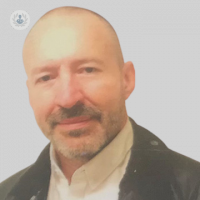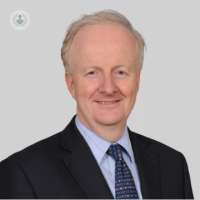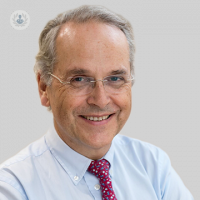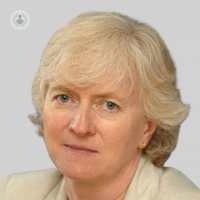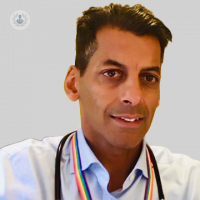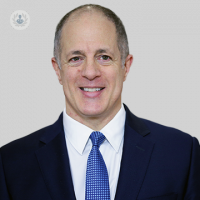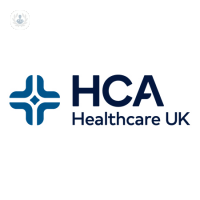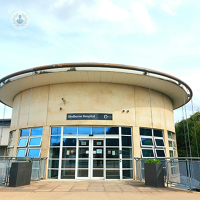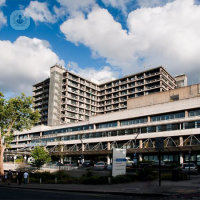What are varicose veins?
Varicose veins are enlarged and swollen veins, usually forming in the legs and feet. Often they can appear as lumpy, blue or purple and bulging. Although varicose veins are frequently a cosmetic concern, for some people they can also cause pain and discomfort, and can sometimes lead to more serious problems.
There are different types of varicose veins, including:
- Reticular – red and grouped closely together.
- Trunk – close to the skin’s surface and very thick.
- Telangiectasia – also known as spider veins, they appear as small groups of blue or red veins that do not bulge.

What are the symptoms of varicose veins?
The main symptoms of varicose veins include:
- heavy, aching legs
- burning or throbbing in the legs
- dry, itchy skin on the affected veins
- cramps in the legs, especially at night
- swollen ankles and feet
What causes varicose veins?
Varicose veins occur when the valves inside the veins malfunction. Blood should flow smoothly to the heart, but if a valve is weakened or damaged, blood can flow backwards and collect in the veins. This eventually results in swollen, varicose veins.
There are certain risk factors associated with developing varicose veins, including:
- older age
- pregnancy
- being female
- being overweight
- having family members with varicose veins
- standing for long periods over time
How can varicose veins be prevented?
There is little evidence that indicates varicose veins can be prevented, however, techniques that improve circulation are thought to reduce the risk of developing them.
There are also measures that can help relieve the symptoms caused by varicose veins:
- Exercising regularly, to maintain a healthy weight and to improve circulation.
- Avoid standing for long periods, and to move around frequently.
- If there is pain, raise the legs on pillows throughout the day to relieve the discomfort.
What is the treatment for varicose veins?
Initially, treatment for varicose veins is usually the use of compression socks or stockings, exercising regularly and elevating the legs when in discomfort.
However, if they are still causing pain and discomfort or have caused complications, then there are other treatment options, including:
- Sclerotherapy – special foam is used to close the affected veins.
- Endothermal ablation – heat is used to seal the veins.
- Ligation and stripping – the affected veins are removed.
Varicose veins are treated by a vascular surgeon.
05-29-2014 10-31-2023Varicose veins
What are varicose veins?
Varicose veins are enlarged and swollen veins, usually forming in the legs and feet. Often they can appear as lumpy, blue or purple and bulging. Although varicose veins are frequently a cosmetic concern, for some people they can also cause pain and discomfort, and can sometimes lead to more serious problems.
There are different types of varicose veins, including:
- Reticular – red and grouped closely together.
- Trunk – close to the skin’s surface and very thick.
- Telangiectasia – also known as spider veins, they appear as small groups of blue or red veins that do not bulge.

What are the symptoms of varicose veins?
The main symptoms of varicose veins include:
- heavy, aching legs
- burning or throbbing in the legs
- dry, itchy skin on the affected veins
- cramps in the legs, especially at night
- swollen ankles and feet
What causes varicose veins?
Varicose veins occur when the valves inside the veins malfunction. Blood should flow smoothly to the heart, but if a valve is weakened or damaged, blood can flow backwards and collect in the veins. This eventually results in swollen, varicose veins.
There are certain risk factors associated with developing varicose veins, including:
- older age
- pregnancy
- being female
- being overweight
- having family members with varicose veins
- standing for long periods over time
How can varicose veins be prevented?
There is little evidence that indicates varicose veins can be prevented, however, techniques that improve circulation are thought to reduce the risk of developing them.
There are also measures that can help relieve the symptoms caused by varicose veins:
- Exercising regularly, to maintain a healthy weight and to improve circulation.
- Avoid standing for long periods, and to move around frequently.
- If there is pain, raise the legs on pillows throughout the day to relieve the discomfort.
What is the treatment for varicose veins?
Initially, treatment for varicose veins is usually the use of compression socks or stockings, exercising regularly and elevating the legs when in discomfort.
However, if they are still causing pain and discomfort or have caused complications, then there are other treatment options, including:
- Sclerotherapy – special foam is used to close the affected veins.
- Endothermal ablation – heat is used to seal the veins.
- Ligation and stripping – the affected veins are removed.
Varicose veins are treated by a vascular surgeon.
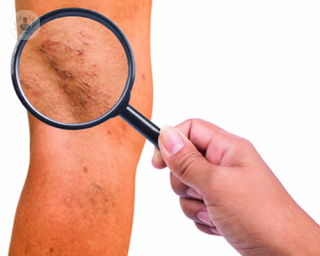

EVLA: Endovenous laser ablation for varicose veins
By Professor Vassilis Hadjianastassiou
2024-11-21
Varicose veins can be treated in a variety of ways. In this article, Professor Vassilis Hadjianastassiou goes into thorough explanation about what to expect in the modern EVLA procedure and afterwards. See more
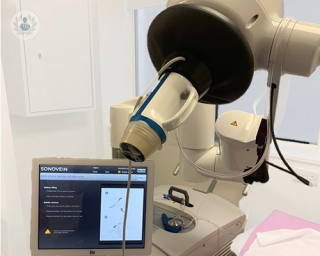

Is HIFU the best treatment for varicose veins?
By Professor Mark Whiteley
2024-11-21
HIFU (“High-Intensity Focused Ultrasound”) is a new non-invasive way to treat varicose veins using ultrasound. There are huge advantages to HIFU over every other treatment for varicose veins, in the cases where HIFU can be used. Professor Mark Whiteley walks us through why HIFU is one of the best ways to treat varicose veins. See more


Varicose vein treatment: three reasons why treatment fails
By Dr Omar Abu-Bakr
2024-11-21
Varicose veins, swollen veins which are dark blue or purple in colour, can affect people's confidence and make them self-conscious. Treatment is widely available but unfortunately is not always successful and can leads to recurrence of the varicose veins. In this article, renowned consultant venous surgeon, Dr Omar Abu-Bakr explains why this can occur and what patients can expect from high quality treatment. See more
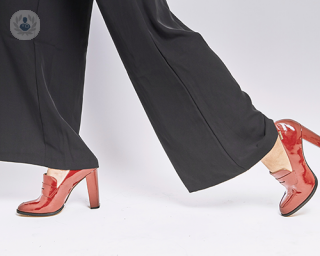

Varicose vein removal: EMWA, EVLA and new advances in treatment
By Mr Patrick Lintott
2024-11-21
Varicose veins are enlarged veins blue or dark purple in colour that usually appear on the legs and feet. Here, Mr Patrick Lintott, highly esteemed consultant vascular surgeon, provides a detailed insight into the latest innovations in treatment for varicose veins, including ablation, sclerotherapy and phlebectomy treatments. See more
Experts in Varicose veins
-
Professor Alun Davies
Vascular surgeryExpert in:
- Varicose veins
- Deep vein thrombosis (DVT)
- Aortic aneurysms
- Hyperhidrosis
- Venous ulcer
- Carotid endarterectomy
-
Mr Philip Coleridge Smith
Vascular surgeryExpert in:
- Varicose veins
- Venous ulcer
- Venous insufficiency
- Thrombosis
- Spider veins (thread veins)
- Deep vein thrombosis (DVT)
-
Ms Sophie Renton
Vascular surgeryExpert in:
- Carotid endarterectomy
- Varicose veins
- Varicose veins surgery
- Venous ulcer
- Peripheral arterial disease
- Diabetic foot
-
Mr Sudip Ray
Vascular surgeryExpert in:
- Varicose veins
- Deep vein thrombosis (DVT)
- Minimally invasive artery surgery
- Peripheral arterial disease
- Varicose veins surgery
- Foam sclerotherapy
-
Mr Ian Franklin
Vascular surgeryExpert in:
- Deep vein thrombosis (DVT)
- Leg ulcers
- Spider veins (thread veins)
- Varicose veins
- Lymphoedema
- Pelvic congestion syndrome
- See all

The Princess Grace Hospital - part of HCA Healthcare
The Princess Grace Hospital - part of HCA Healthcare
The Princess Grace Hospital, 42-52 Nottingham Pl, W1U 5NY
No existe teléfono en el centro.
By using the telephone number provided by TOP DOCTORS, you automatically agree to let us use your phone number for statistical and commercial purposes. For further information, read our Privacy Policy
Top Doctors

The Shelburne Hospital - part of Circle Health Group
The Shelburne Hospital - part of Circle Health Group
Queen Alexandra Rd, High Wycombe HP11 2TR
No existe teléfono en el centro.
By using the telephone number provided by TOP DOCTORS, you automatically agree to let us use your phone number for statistical and commercial purposes. For further information, read our Privacy Policy
Top Doctors

The Royal Free Hospital
The Royal Free Hospital
Pond Street, Hampstead. NW3 2QG
No existe teléfono en el centro.
By using the telephone number provided by TOP DOCTORS, you automatically agree to let us use your phone number for statistical and commercial purposes. For further information, read our Privacy Policy
Top Doctors
-
The Princess Grace Hospital - part of HCA Healthcare
The Princess Grace Hospital, 42-52 Nottingham Pl, W1U 5NY, Central LondonExpert in:
- Cancer
- General Surgery
- Orthopaedic surgery
- Robotic Surgery
- Intensive care
- Sports Medicine
-
The Shelburne Hospital - part of Circle Health Group
Queen Alexandra Rd, High Wycombe HP11 2TR, High WycombeExpert in:
- Abdominal ultrasound
- Allergies Ophthalmological
- Clinical analysis
- Hip
- Cataracts
- Full Body Check
-
The Royal Free Hospital
Pond Street, Hampstead. NW3 2QG, Central LondonExpert in:
- General Surgery
- Orthopaedic surgery
- Robotic Surgery
- Dermatology
- Obstetrics and Gynaecology
- Paediatrics
- See all
- Most viewed diseases, medical tests, and treatments
- Hormone therapy
- Nutrition
- Weight loss injections
- Endermologie
- Polynucleotides
- Testicular ultrasound
- Breast ultrasound
- Endovenous laser treatment (EVLA)
- Vaginal dryness
- Anxiety
